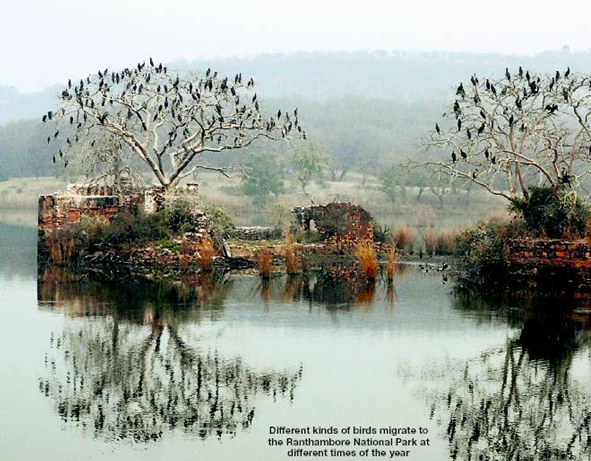Ranthambore National Park
This is a collection of articles archived for the excellence of their content. Readers will be able to edit existing articles and post new articles directly |
Getting Wild...
Watch the untamed creatures roam the jungles of Ranthambore National Park
SIMIT BHAGAT
Ahalf hour drive from the resort took me to the heart of the Ranthambore National Park, India’s largest tracts of bush forest and a unique habitat for the Bengal tiger. I am in a Canter vehicle that clatters its way towards the forest gate of the National Park.
As we enter the park, we are greeted by the langur and peafowls, which are commonly found here. And what can one say about Ranthambhore? Although the striped beauty is undoubtedly its star attraction, there is also a 1,000-year old fort, which winds around central parts of the reserve, seasoning the tourist’s already overflowing plate with some history and culture – this is, after all, Rajasthan!
Driving slowly by the lake, I saw sounders of wild boar, herds of spotted deer, sambar and nilgai and several troupes of playful langurs. The mammalian diversity of the park mirrors its significance as a premier conservation site – apart from its flagship attraction, the forest is home to the leopard, the sloth bear, the jackal and the hyena among the carnivores. Even ornithologists have no cause for complaint either – by the lake sides, a phenomenal diversity of birdlife presents itself, including migrants such as geese, plovers and stints feeding and around 250 species of birds, making it an important bird area in its own right.
Easily the most visible of these, is the plucky Rufous Treepie, which is famous for its catwalks on the top of safari vans, strutting its brilliant plumage of black, saffron and white to cheer up tourists who’ve had no luck with the sanctuary’s more famous attractions! By now I’ve already spent a wonderful day roaming around the beautiful forests; its most famous resident has so far proved elusive.
It’s getting dark and as we take rounds in the big cat country, a loud frantic langur alarm gets everyone to its toes. As we take note of the loud call to stop the vehicle, the call further intensifies. We wait. And wait. The moments are frozen and I can hear my heart beat in the silence. I know it’s here, now. So close… As I look around to get a glimpse of the striped beauty, there he comes from the dense bush. With his topaz eyes unflinchingly focused on us – what he perceives as a threat – he begins his slow approach towards us.We move a few steps ahead and are just few meters away from the molten gold. I could feel the power of its presence, the stealth of one of nature’s most efficient predators. Looking at us – moving away from him – he calms down and takes the weight off his feet.
As if he is posing for a photo shoot for the tourists sitting in the vehicles. I was blessed and there is no experience that comes even close to an encounter with a wild tiger. At dusk, while on my way back, the driver switched off the engine to listen to the evening sounds of the forest, the bugle-like alarm call of a peacock broke the silence seconded by a loud langur call, probably signifying that the tiger was on the move. Visitors cannot stay in the park after nightfall, but this is when civets, hyenas, porcupines and hares are most active.
Contents |
FACT FILE
Spread across about 1,300 square kilometres in Eastern Rajasthan, Ranthambore was declared a wildlife sanctuary in 1955 and was also one of the original Project Tiger reserves. The park area itself was once the hunting preserve of the Maharajas of Jaipur and many tiger shoots took place here, but today the park had earned itself the distinction of being one of the world’s best-known forests.
Tourists to Rajasthan find Ranthambore a good break from the monotony of the State’s never-ending forts and the Park’s convenient location near Sawai Madhopur on the Mumbai - Delhi railway line, appeals to weekend visitors as well.
Sawai Madhopur station is virtually as the British left it; red brick and mortar, complete with arches and columns, a touch dirtier and more crowded with locals and, of course, the thousands of visitors who make an annual pilgrimage each winter to savour this internationally celebrated tiger destination.
The park is open from October to June. Post monsoon, the park is closed, as the roads are not navigable till late September. The months between November and February are the most popular for visitors, after which it is too hot for all but the most enthusiastic.
Different kinds of birds migrate to the Ranthambore National Park at different times of the year
Tiger population
2018: 67 tigers, an all-time high
At 67, Ranthambhore tiger numbers at all-time high, January 26, 2018: The Times of India
The thriving tiger population at Rajasthan’s Ranthambhore Tiger Reserve is now the highest in the park’s history at 67, RTR officials said. The numbers are becoming more than what the park can handle, leading to tigers straying out into nearby areas.
Officials said there are now 21 male tigers, 20 females and 26 cubs in the reserve. With such high big cat numbers, the park is becoming a nursery for tigers populating other forests in the state.
Three tigers (T-72, 80 and 92) strayed out into the neighbouring Karauli forests. Among them one was a female and two males. The number of Ranthambhore tigers that have strayed into Madhya Pradesh is not exactly known.
Apart from the ones that are dispersing out naturally, three of the park’s tigers to be translocated to Mukundara forests in Kota district. Besides that, NTCA’s permission to translocate one more tiger to Sariska Tiger Reserve (STR) is long pending.
When STR became the first protected sanctuary to lose all its tigers to poaching in 2005, RTR tigers had re-populated the reserve. In all, eight tigers from Ranthambore were taken to Sariska under the reintroduction plan between 2008 and 2013.
2019/ severe space crunch
Ajay Singh, Oct 11, 2019: The Times of India

From: Ajay Singh, Oct 11, 2019: The Times of India
Key Highlights
Rajasthan’s chief wildlife warden has put forward a proposal to the National Tiger Conservation Authority (NTCA), to shift the big cats to Mukundra Hills Tiger Reserve (MHTR), Sariska Tiger Reserve (STR) and Ramgarh Vishdhari Wildlife Sanctuary in Bundi
The severe space crunch in Ranthambore has led to young tigers either killing humans on the park’s periphery or dying in territorial fights
JAIPUR: The number of tigers in Ranthambore Tiger Reserve (RTR) has increased to the point that the reserve can no longer sustain the big cats that are currently inhabiting the area.
Rajasthan’s chief wildlife warden Arindam Tomar has put forward a proposal to the National Tiger Conservation Authority (NTCA), the apex tiger conservation body in the country, to shift the big cats to Mukundra Hills Tiger Reserve (MHTR), Sariska Tiger Reserve (STR) and Ramgarh Vishdhari Wildlife Sanctuary in Bundi.
The Ranthambore reserve has a core area of 392 sq km, with a buffer zone of 1,342 sq km. Of the total area of little over 1,700 sq km in RTR, only 600 sq km can be used by tigers. The park has a total of 61 tigers, including 27 male and 24 female cats.
As per a rough estimate, a male tiger requires an area of approximately 25 sq km and a female about 15 sq km, showing how the big cats are cramped for space. Mukesh Saini, a divisional forest officer (DFO), of RNP, said, “Currently, the park has total of 61 big cats, including 27 males, 24 females and 10 cubs. A study will be conducted to identify the young tigers, which are finding it difficult to find new territories. Based on the study, a proposal will be prepared to shift them from Ranthambore.”
The severe space crunch in Ranthambore has led to young tigers either killing humans on the park’s periphery or dying in territorial fights. Human-tiger conflicts too have reached alarming proportions in Ranthambore.
“Three people have now been killed and one injured within a span of one month in Sawai Madhopur and nearby districts. All attacks were made by young adults. Also, two big cats died in the park this year from territorial fights,” a source said.
